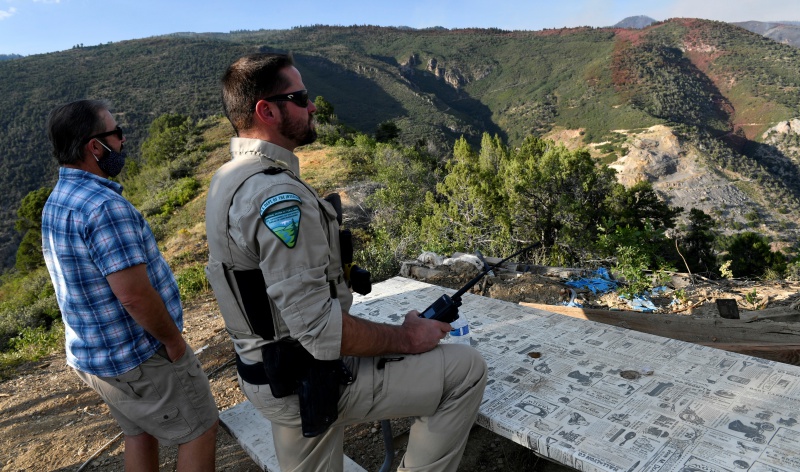
A Bureau of Land Management policy may weaken enforcement of federal laws and regulations on public lands.
Nearly 130 federal law enforcement officers descended on the small town of Blanding, Utah in 2009 to arrest residents who had illegally collected Native American artifacts on nearby federal lands. Investigators eventually recovered about 40,000 artifacts taken from Native people’s ancestral sites and graves.
Native Nations welcomed the operation as the first step to curbing decades of cultural artifact looting in the area. But Blanding residents claimed the operation was overzealous and abusive. In the aftermath, when three people involved died by suicide, community members and Utah politicians blamed the aggressive enforcement tactics.
Some observers saw the Blanding operation as a necessary law enforcement action, but others saw federal overreach. The same divide now arises over a directive that changes the chain of command for Bureau of Land Management (BLM) law enforcement officers, giving political figures responsibility for enforcement. Although some commentators welcome the change, plenty of critics warn that the policy jeopardizes the integrity of federal laws and regulations on public lands.
The BLM’s Office of Law Enforcement and Security (OLES) enforces federal laws and regulations—such as the Native American Graves Protection and Repatriation Act and designated wilderness area protections—on 245 million acres of public lands.
The agency employs nearly 200 rangers who wield traditional law enforcement powers, such as carrying firearms, executing warrants, and making arrests. With an average of more than one million acres of land to oversee, rangers’ duties can vary widely. Rangers in northern states may focus on illegal marijuana cultivation, while rangers in the southwest deserts monitor for off-highway vehicles and arson.
Until recently, state and local BLM officials directly supervised rangers and the OLES exercised “functional oversight.” Proponents of this system have argued that these regional leaders understand the localized challenges that BLM rangers face in enforcing complex federal laws and regulations across vast swaths of land.
During the final week of the Trump Administration, however, the BLM changed that reporting structure. Now the BLM’s internal manual charges the OLES with “maintaining direct oversight and executive-level management of all the BLM’s law enforcement program activities” and providing “direct management of field level law enforcement programs.” According to the BLM, this new directive alters rangers’ chain of command. Under the new structure, rangers report directly to managers in the OLES without the supervisory involvement of state and local BLM officials.
The BLM press release announcing the change in January emphasized the primary impetus for the new reporting structure: a 2002 Office of the Inspector General report that critiqued the agency for placing law enforcement officers under the supervision of managers with “limited or no law enforcement experience or training.”
The new reporting structure corrects that problem and modernizes the chain of command, according to the BLM. Because the new supervisors are law enforcement officers themselves, the BLM explains, they will “fully understand the difficult responsibilities” of rangers and promote greater “control and accountability.”
But some observers question why the BLM chose to implement these 20-year-old recommendations now, particularly because the new structure reportedly conflicts with recent, nearly finalized recommendations that the agency give state-level BLM officials more ranger management authority.
Critics contend that the new reporting structure is in fact designed to give political appointees, such as regional special agents and the OLES director, control of law enforcement on public lands. These commentators caution against the change because how—and indeed, whether—the BLM enforces federal laws and regulations is a partisan political issue.
Republican members of Congress have repeatedly introduced legislation to abolish the OLES and give state and local governments responsibility for enforcing federal laws on federal lands. U.S. Senator Mike Lee (R-Utah) chaired a Senate hearing on the issue at which he denounced the OLES as “militarized criminal law enforcement” prone to “heavy handed abuse” in rural communities.
These views reach beyond the Republican Party. A so-called constitutional sheriff movement claims that the Constitution gives county sheriffs law enforcement authority over their jurisdictions—including federal public lands—and that this authority supersedes all other authority, such as that possessed by federal agents and even the President.
When constitutional sheriffs are elected, they often “undermine enforcement of federal public lands policies, making it easier for others to use public lands illegally for such purposes as grazing livestock or driving all-terrain vehicles,” notes political scientist Zoe Nemerever in recent research. Nemerever also shows that counties with constitutional sheriffs “are 50 percent more likely to have violence against BLM employees than other counties.”
Constitutional sheriff supporters have led highly publicized actions to violate federal land laws. For instance, following a dispute with the BLM about grazing fees, rancher and activist Cliven Bundy led hundreds of people in a 2014 armed standoff with the agency. His son Ammon led an armed militia that forcibly occupied a federal wildlife refuge in 2016, causing one death and approximately $6 million in damage. In 2007, Phil Lyman led nearly 50 people on an ATV protest ride along a trail where the BLM prohibited motorized vehicles to protect cultural artifacts. Some commentators suggest that the constitutional sheriff movement could be tied to the Capitol Insurrection in early January.
The combination of these political trends and the new BLM reporting structure should trouble advocates for public lands law enforcement, according to Aaron Weiss of the Center for Western Priorities. Weiss cautions that the new chain of command creates a vulnerability that opponents of BLM law enforcement could exploit. Under the new policy, Weiss warns, “a future administration that is friendly to anti-government sheriffs can defer to seditionists who stage armed takeovers of public land as a matter of official government policy.”
This dismal forecast will not happen soon—if, indeed, ever. Some BLM officials reportedly decided to wait to implement the change until after President Joseph R. Biden’s inauguration. The Biden Administration is committed to public lands protection and may well reverse the reporting structure changes.
But the Biden Administration will not last forever. Only time will tell whether the friction between growing anti-government forces and the BLM will disrupt protections that the law gives to public lands.



